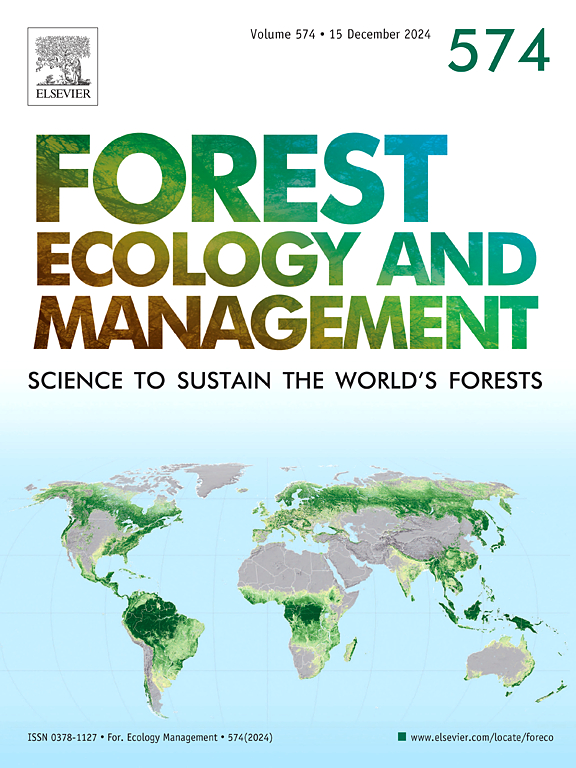Improved allometry and heartwood development of Sequoia sempervirens in secondary forests
IF 3.7
2区 农林科学
Q1 FORESTRY
引用次数: 0
Abstract
Heartwood is the majority of a tall tree’s biomass, and durability of this material is a major contributor to longevity. Toxins deposited during heartwood formation (extractives) are largely responsible for its durability and can be quantified by chemical extractions and well-replicated comparisons of sapwood and heartwood densities. Using the latter approach, we explore variation in heartwood attributes of the tallest species, Sequoia sempervirens, in secondary forests regenerating post logging in California. After climbing, measuring, and core-sampling 77 dominant trees (96–202 yr old, 56–87 m tall, 6–37 Mg biomass) in 18 locations distributed from northern rainforests to warmer, drier, and less foggy margins of the species range in California, we combine improved allometry with dendrochronology to reconstruct tree sizes for developmental analysis. Northern trees have the lowest wood densities, highest wood volume increment, fastest increase in the heartwood proportion of wood volume increment, highest growth efficiency (biomass produced per unit leaf mass), and lowest extractive proportion of heartwood increment, whereas marginal trees are at the opposite extreme and central trees are intermediate in all these metrics. In the climatically distinct and fire-prone canyons of the marginal range, higher density and extractive content of heartwood contribute to long-term carbon sequestration and persistence of Sequoia-dominated vegetation. Allowing Sequoia to reach great height may be the best way to improve carbon sequestration in the core range, where heartwood extractive content and decay resistance are lower in secondary forests than primary (old-growth) forests. Biophysical constraints on turgor pressure in lofty crowns may limit sapwood production and promote heartwood deposition throughout the trunk, explaining why tall trees in primary forests have higher heartwood extractive content than much shorter trees in nearby secondary forests. Understanding the causes of regional variation in heartwood attributes requires further study, including outside California where Sequoia is widely planted for its extraordinary values.
改良的次生林红杉异速生长和心材发育
心材是高大树木生物量的主要组成部分,这种材料的耐久性是长寿的主要因素。在心材形成过程中沉积的毒素(提取物)是其持久性的主要原因,可以通过化学提取和边材和心材密度的良好复制比较来量化。采用后一种方法,我们研究了加州次生林砍伐后再生过程中最高树种sempervirens的心材属性变化。在从北部雨林到加州温暖、干燥、少雾的物种范围边缘的18个地点,对77棵优势树(96-202 年,56-87 米高,6-37毫克生物量)进行攀爬、测量和核心取样后,我们将改进的异速测量法与树木年代学相结合,重建了树木的大小,用于发育分析。北方乔木的木材密度最低,木材体积增量最高,木材体积增量中心材比例增长最快,生长效率(单位叶质量产生的生物量)最高,心材增量提取比例最低,而边缘乔木处于相反的极端,中心乔木处于中间。在气候差异大、火灾易发的边缘地带峡谷中,较高的心材密度和提取物含量有助于红杉为主植被的长期固碳和持久性。允许红杉达到很高的高度可能是改善核心范围内碳封存的最佳方法,在核心范围内,次生林的心材提取物含量和抗腐性低于原生林(原生林)。高大树冠膨胀压力的生物物理限制可能会限制边缘材的生产,并促进整个树干的心材沉积,这解释了为什么原生林中的高大树木比附近次生林中的矮得多的树木具有更高的心材提取物含量。了解心材属性区域差异的原因需要进一步研究,包括加州以外的红杉因其非凡的价值而被广泛种植的地区。
本文章由计算机程序翻译,如有差异,请以英文原文为准。
求助全文
约1分钟内获得全文
求助全文
来源期刊

Forest Ecology and Management
农林科学-林学
CiteScore
7.50
自引率
10.80%
发文量
665
审稿时长
39 days
期刊介绍:
Forest Ecology and Management publishes scientific articles linking forest ecology with forest management, focusing on the application of biological, ecological and social knowledge to the management and conservation of plantations and natural forests. The scope of the journal includes all forest ecosystems of the world.
A peer-review process ensures the quality and international interest of the manuscripts accepted for publication. The journal encourages communication between scientists in disparate fields who share a common interest in ecology and forest management, bridging the gap between research workers and forest managers.
We encourage submission of papers that will have the strongest interest and value to the Journal''s international readership. Some key features of papers with strong interest include:
1. Clear connections between the ecology and management of forests;
2. Novel ideas or approaches to important challenges in forest ecology and management;
3. Studies that address a population of interest beyond the scale of single research sites, Three key points in the design of forest experiments, Forest Ecology and Management 255 (2008) 2022-2023);
4. Review Articles on timely, important topics. Authors are welcome to contact one of the editors to discuss the suitability of a potential review manuscript.
The Journal encourages proposals for special issues examining important areas of forest ecology and management. Potential guest editors should contact any of the Editors to begin discussions about topics, potential papers, and other details.
 求助内容:
求助内容: 应助结果提醒方式:
应助结果提醒方式:


